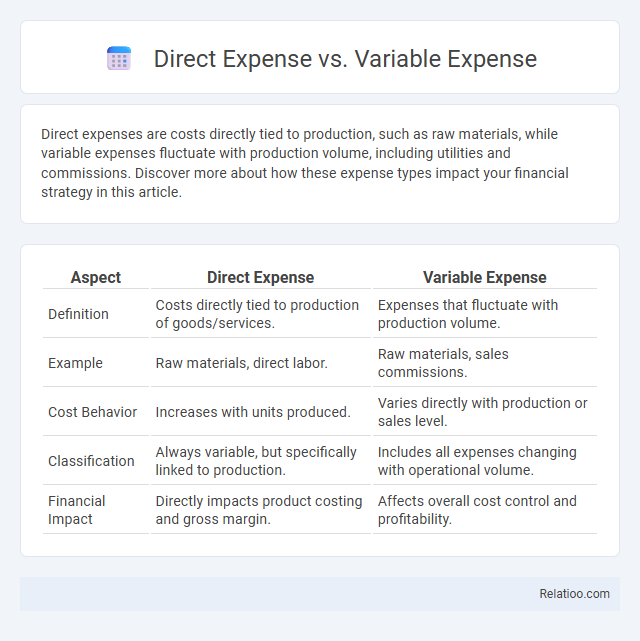Direct expenses are costs directly tied to production, such as raw materials, while variable expenses fluctuate with production volume, including utilities and commissions. Discover more about how these expense types impact your financial strategy in this article.
Table of Comparison
| Aspect | Direct Expense | Variable Expense |
|---|---|---|
| Definition | Costs directly tied to production of goods/services. | Expenses that fluctuate with production volume. |
| Example | Raw materials, direct labor. | Raw materials, sales commissions. |
| Cost Behavior | Increases with units produced. | Varies directly with production or sales level. |
| Classification | Always variable, but specifically linked to production. | Includes all expenses changing with operational volume. |
| Financial Impact | Directly impacts product costing and gross margin. | Affects overall cost control and profitability. |
Understanding Direct Expenses
Understanding direct expenses is crucial for accurately managing your business costs, as these expenses are directly tied to the production of goods or services, such as raw materials and labor. Variable expenses fluctuate with production volume but may include both direct and indirect expenses, such as utilities or sales commissions. Clarifying the distinction helps in precise cost allocation, budgeting, and financial analysis to improve profitability and operational efficiency.
Defining Variable Expenses
Variable expenses fluctuate directly with production or sales volume, including costs like raw materials and direct labor, making them essential for calculating Your operational budget. Direct expenses are specific costs directly tied to the production of goods, such as raw materials, but may not vary with sales volume if production remains constant. Variable expenses differ from fixed expenses by changing in proportion to business activity, helping managers make informed decisions about cost control and pricing strategies.
Key Differences Between Direct and Variable Expenses
Direct expenses are costs directly attributable to the production of goods or services, such as raw materials and labor, while variable expenses fluctuate with production volume but may include both direct and indirect costs, like utility bills or sales commissions. Variable expenses change in total proportionally with the level of output, whereas direct expenses maintain a clear, traceable link to specific products or projects. Understanding this distinction helps businesses accurately allocate costs for pricing, budgeting, and financial analysis.
Examples of Direct Expenses
Direct expenses are costs directly attributable to the production of goods or services, such as raw materials, manufacturing labor, and factory supplies. Variable expenses fluctuate with production volume, including costs like sales commissions, shipping fees, and utility expenses tied to manufacturing operations. Understanding how your business distinguishes direct expenses from variable and fixed expenses helps optimize budgeting and cost management strategies.
Examples of Variable Expenses
Variable expenses fluctuate with your business activity and include costs such as raw materials, direct labor, and sales commissions. Direct expenses are specifically tied to the production of goods or services, like packaging or shipping costs, which are often variable in nature. Examples of variable expenses you may encounter include utility costs that increase with manufacturing volume and transportation fees linked to sales performance.
Impact on Financial Statements
Direct expenses such as raw materials and labor costs directly affect the cost of goods sold on your income statement, reducing gross profit. Variable expenses fluctuate with production volume and are recorded on both the income statement as operational costs and on the cash flow statement, impacting net cash flow. Understanding the distinctions between direct, variable, and fixed expenses helps improve financial forecasting and cost management on your balance sheet and income statement.
How Direct and Variable Expenses Affect Profit Margins
Direct expenses, such as raw materials and labor costs, directly impact your product's cost, reducing profit margins with each unit produced. Variable expenses fluctuate with production volume, affecting overall profitability by increasing costs as output rises. Understanding the relationship between direct and variable expenses helps you manage and optimize profit margins effectively.
Recording Direct vs Variable Expenses in Accounting
Recording direct expenses involves allocating costs directly associated with production, such as raw materials and labor, ensuring accurate product costing and inventory valuation. Variable expenses, including utilities and sales commissions, fluctuate with production volume but may not be directly traceable to specific products, requiring careful categorization for financial analysis. Properly distinguishing between direct and variable expenses in accounting enhances cost control, budgeting accuracy, and profitability assessment.
Importance in Cost Control and Budgeting
Direct expenses, variable expenses, and fixed expenses each play a crucial role in cost control and budgeting by helping you accurately allocate resources and forecast financial performance. Direct expenses, directly tied to production, enable precise product costing, while variable expenses fluctuate with production levels, impacting cash flow and profitability analysis. Understanding these expense types allows for effective budgeting strategies and cost management, ensuring financial stability and optimized operational efficiency.
Frequently Asked Questions: Direct vs Variable Expenses
Direct expenses are costs directly traceable to a specific product or service, such as raw materials and labor, with clear cause-effect relationships. Variable expenses fluctuate with production volume but may include indirect costs like utilities or indirect labor, making them less straightforward than direct expenses. Frequently asked questions often clarify that while all direct expenses are variable, not all variable expenses qualify as direct, emphasizing the importance of accurate categorization for financial analysis and cost control.

Infographic: Direct Expense vs Variable Expense
 relatioo.com
relatioo.com